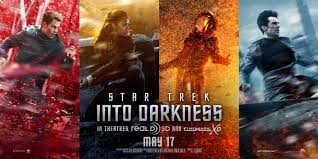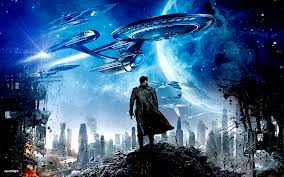In the 2009 Star Trek movie, which we’ll call Alternate Reality, we rejoiced because they’d gotten it right. They took our old friends and re-made them perfectly. Perfectly cast, perfectly written, and even better, because Captain Pike wasn’t a head attached to a box that beeped once for yes and twice for no.
We rejoiced for the familiarity of the people: Spock raised his eyebrow just so. Adjusted his shirt like that. Said, “Fascinating.” Kirk was brash and disdained regulations. McCoy was plainly and simply (and oh so metaphorically) Bones. It all clicked. Plus I cried my eyes out at the beginning when a young man gave his life for his crew.
Someone else does it this time. In a neat nod to the needs of the many, we see a mirror image of a scene we’ve loved for years. This time it hurts more. This time it matters more.
Into Darkness is the story of Captain Kirk being brash, bold, sacrificial, facing a Kobayashi Maru lose-lose scenario with gut-wrenching honesty: “I don’t know what I’m supposed to do, but I know what I can do.” Isn’t that how it often is in times of crisis? No sci-fi there. That’s real.
This is the story of a friendship we’ve admired for decades being formed. Last time, we saw its tentative beginnings. This time we see the bond take hold, take root, become permanent. It’s not breakable now.
But mostly, this is the story of Commander Spock exploding out of Science Officer nerdness into full-blow action-star mode. Yeah, we know he knows everything and can fix anything and is the steady logical mind bearing up and ballasting Kirk’s brash bravado. But he’s far more than that now. He’s da man and he rocks righteous violence and delivers righteous vengeance. This is my Spock. We always knew he could do this—not just when he lost control in freak moments where his human weaknesses overcome him, but when anger needs to be unchecked and unhindered. When the needs of the one outweigh the need of a half-Vulcan chill-machine to stay calm, Spock unleashes his five-times-human strength, powerfully delivering–without reserve, without second thoughts–deserved and necessary brutality.
He can unleash his anger because he is no longer hampered by his previously-greatest fear: that he might slip and show that he’s half-human. That doesn’t matter now. He’s faced death alone and afraid, resolved to die without panic, without psychological disintegration. He’s faced the end of the world and the end of himself with the knowledge that sometimes you must do what you must do and damn the torpedoes (or lava waves, as the case may be). Having faced that, he is free to be what he knows he needs to be for his friend, when the moment comes where only he stands between his friend and death.
There are other heroic, self-giving moments in this movie, but I’ve been watching Spock for a long time now, and I am pleased to say that what we see here is Real Spock—embracing his Vulcanness, embracing his humanness—being who he really is and, in doing so, saving himself and his friend.
End paeon.
And yet I wonder whether we need to move on into plots and characters that are less familiar in order for future movies in this franchise to do well. We don’t really want to see re-makes: we want new adventures with aliens we’ve never thought of before, planets we haven’t yet encountered, dangers yet unconceived. We want new, wildly unpredictable things to happen: like Scotty’s “friend” betraying him, or Mr. Chekov growing up. I don’t really want Yeoman Rand to show up or Charlie X or the Horta. I want to go where no Trekkie has gone before. Nero gave us that in Alternate Reality, so we know the screenwriters are up to the job.
I’ve read that Zachary Quinto is, earlier rumors to the contrary notwithstanding, onboard for the next installment. At least we know that if Spock dies in that one, he will die daring greatly, his face marred by dust and sweat and blood, not sitting at his console monotoning the infinitesimally-small odds of his survival.
Also endearing here were Mr. Sulu’s first moments in The Captain’s Chair, portending a great future with (one hopes) the U.S.S. Excelsior, and perhaps a cup of tea. He, as we say here, deals with the bad guy, with good effect.
Speaking of the bad guy, let me just say that Benedict Cumberbatch has the most sonorous voice in the history of voices and may he continue to talk like that forever. He is the best of villains—the kind you can understand, empathize with, and root for, if only part of the time. He gets a chilly send-off, but one is left with a feeling that they are going to put him down on Ceti Alpha Five and things are going to go south from there, without, it is hoped, any creatures crawling into his ears and lodging there, because he’s scary enough when he’s in good health loving his peeps.
The screenwriters did a great job of giving us real men reacting to terrifying prospects. Real men (even half-Vulcans and three-hundred-year-old Supermen with Superior Intellects) feel, make mistakes, fumble, fall, and occasionally save the beautiful woman (read: USS Enterprise, she of the ample nacelles) at the last second.
Carol Markus shows up. You know what that means. At least they picked a really pretty girl. I hope she sticks around. It is a five-year mission after all. David could be four years old before we’re done. I hope his nanny is the man on the bridge who speaks out of an amplifier on the back of his head, because that is just too cool for words.
Leonard Nimoy. I’m a fan, but this needs to be the end, okay? Unless we can somehow–please oh please–get Shatner on for next time. Bill’s 81, so we need to hurry. What is the use of time-warps if we can’t get Shatner back to teach Chris Pine and Zachary Quinto how to play a little Fizzbin?




